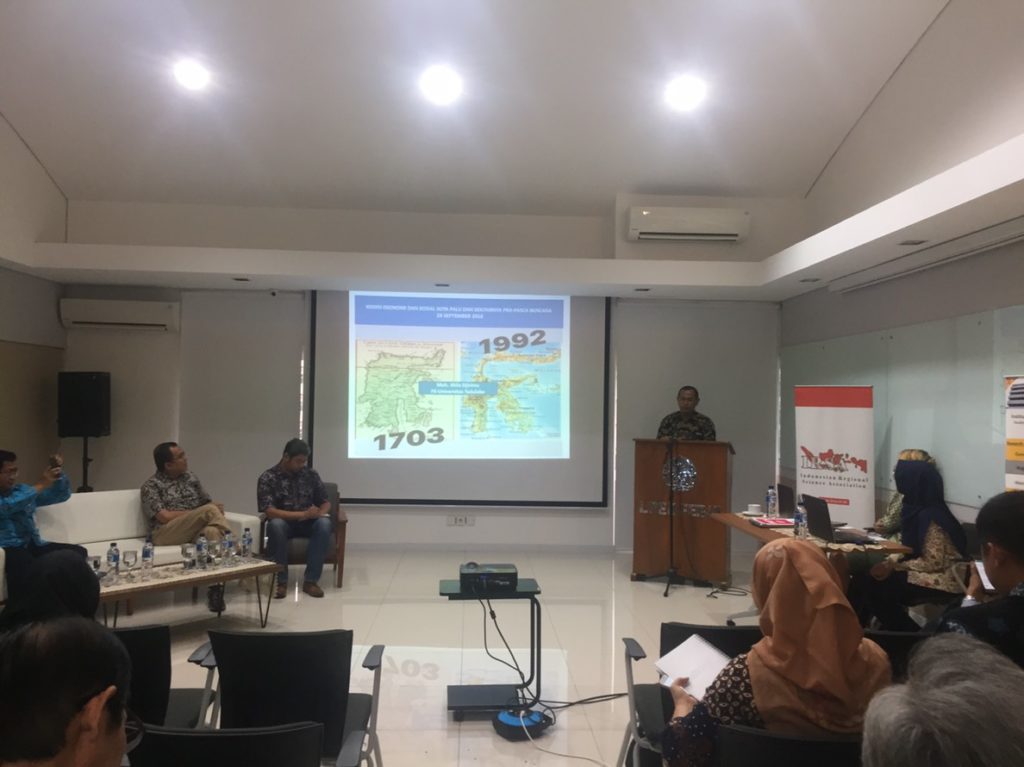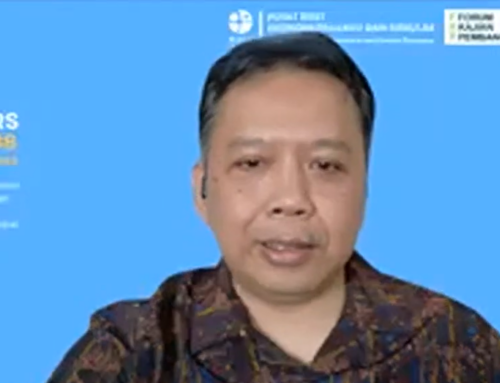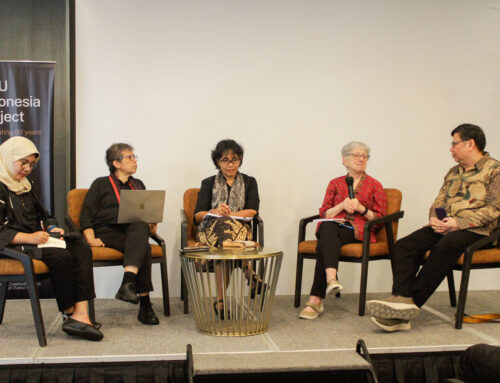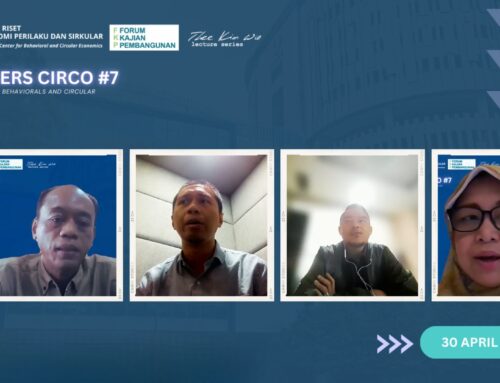Being located in the Ring of Fire, natural disasters are not something that Indonesia is unfamiliar with, yet more needs to be done to improve mitigation and community rebuilding. On Tuesday, 13 November 2018 Indonesia Regional Science Association (IRSA) in collaboration with LPEM FEB UI and The ANU Indonesia Project hosted an FKP event in Jakarta entitled “Seminar Kebencanaan di Indonesia: Dari Sistem Peringatan Dini Hingga Proses Pembangunan Kembali”. About 74 participants attended the event, comprising of government officials, academics, the private sector and NGO representatitves. Professor Budy Resosudarmo (ANU Indonesia Project) chaired the discussion panel.
The event began with a keynote speech by Professor Dwikorita Karnawati (Head of Indonesian Agency for Meteorology, Climatology and Geophysics or BMKG). Professor Karnawati explained how ~75% of industrial and connectivity-related infrastructure in Indonesia are built in areas that are prone to natural disasters. The vision of BMKG is to reduce risk through observation, data processing, and dissemination through social media and mobile networks. In the case of tsunamis, Indonesia currently has 174 censors that are processed by BMKG’s artificial intelligence to predict a tsunami 2 minute before its occurrence. However, this technological advancement also requires officials from BMKG, national and local Disaster Management Agency (BNPB), Ministry of Communication and Information, security forces, and the media to always be ready at all times, which is often not the case. In conclusion, Professor Karnawati emphasized that we cannot simply rely on technology. More importantly we need officials who are available 24 hours, disaster education for citizens, better infrastructure, institutions, and spatial planning.
Ahlis Djirimu (Universitas Tadulako) continued with a presentation about the socioeconomic conditions of Palu and its surroundings before and after the 2018 Central Sulawesi earthquake. High fiscal dependency, ineffective regulations, and poorly performing local representatives have characterized governance of Central Sulawesi prior to the earthquake. This condition is made worse by the unsustainable use of natural resources (e.g. illegal mining, fishing, and logging) by the people. The 2018 earthquake affected four regions the hardest: Donggala, Palu, Parigi, and North Mamuju, which contribute to around 40% of Central Sulawesi’s GDRP. Aside from the loss of lives, the earthquake costs a total material cost of Rp18.48 trillion. Due to the aforementioned poor governance, the quality of public services has not been optimal after the earthquake. Djirimu proposed the integration of local wisdom to the government’s disaster mitigation plan.
Next, Syaiful Mahdi (Universitas Syiah Kuala) presented the socioeconomic factors of Disaster Risk Reduction (DRR) with a case study of Aceh post the 2004 tsunami. The tsunami cost USD4.45 billion (80% of Aceh’s GDRP) and encouraged a massive global community response with over 133 countries and 600 NGOs. Quoting McCarthy (2014), Mahdi explained that even though the rebuilding process in Aceh was one of the biggest investments in history, 50% of the people in Aceh are found vulnerable 8 years after the disaster. Mahdi believes that Indonesia has been relatively successful in adopting scientific and technological knowledge for DRR. However, the same cannot be said for our humanitarian and socio-cultural knowledge. Efforts to bring technology and culture together in DRR must be carried out from both sides; technology must be adapted and culture must also upgrade its narratives.
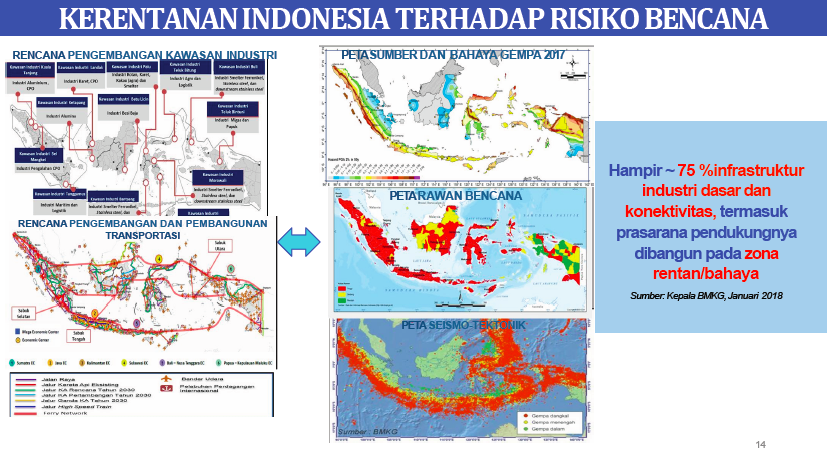
Sumedi Andono Mulyo (Director of Disadvantaged Areas, Transmigration and Rural Areas, Ministry of National Development Planning or Bappenas) presented an economic model of Disaster Risk Reduction (DRR). There are three main factors of disaster risk, namely threats such as fear, vulnerability (physical, economic, environmental, and social), as well as capacity (anticipation, recovery, and response). Indonesia’s biggest challenge in implementing DRR is finding ways to reduce vulnerability and increase capacity. Disaster risk that occurs in each region in Indonesia varies due to the different levels of disaster threat and the capacity. By mapping the factors in each region, risk can be reduced. The economic model being built consists of four stages starting in pre-disaster conditions, post-disaster conditions, recovery, and risk reduction aimed at achieving safe and sustainable improvements. Mulyo believes that the understanding of disaster through economic models will further optimize policies in DRR.
Finally, Jonathan Lassa (Charles Darwin University) presented a critical evaluation of the designs and practices of global and local early warning systems (EWS). The fundamental principle of a warning system is to give out information that will mobilize people into safety. The key elements of EWS implementation are understanding risk, monitoring and warning services, dissemination and communication, and disaster response capabilities. In Indonesia, there are still gaps in perception regarding the development of EWS. The biggest difference lies in the availability of EWS for all major hazards that can be accessed by the community. A successful EWS include strong political recognition, integration with disaster response and education planning, and feedback for future improvements. In a bureaucratic environment, regulations that can control EWS matter in enabling the circumstances to achieve sustainability, innovations, and the overall performance of EWS.
